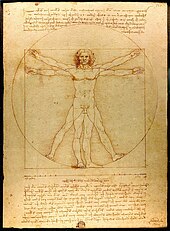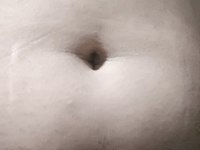
Navel
| Navel | |
|---|---|
 The navel is a protruding, flat or hollowed scar left after the umbilical cord detaches.
| |
| Details | |
| Precursor |
Umbilical cord Ductus venosus |
| Artery | Umbilical artery |
| Vein | Umbilical vein |
| Identifiers | |
| Latin | Umbilicus |
| MeSH | D014472 |
| TA98 | A01.2.04.005 |
| TA2 | 261 |
| FMA | 61584 |
| Anatomical terminology | |
The navel (clinically known as the umbilicus, commonly known as the belly button or tummy button) is a protruding, flat, or hollowed area on the abdomen at the attachment site of the umbilical cord. All placental mammals have a navel, although it is generally more conspicuous in humans.
Structure
The umbilicus is used to visually separate the abdomen into quadrants.
The umbilicus is a prominent scar on the abdomen, with its position being relatively consistent among humans. The skin around the waist at the level of the umbilicus is supplied by the tenth thoracic spinal nerve (T10 dermatome). The umbilicus itself typically lies at a vertical level corresponding to the junction between the L3 and L4 vertebrae, with a normal variation among people between the L3 and L5 vertebrae.
Parts of the adult navel include the "umbilical cord remnant" or "umbilical tip", which is the often protruding scar left by the detachment of the umbilical cord. This is located in the center of the navel, sometimes described as the belly button. Around the cord remnant, is the "umbilical collar", formed by the dense fibrous umbilical ring. Surrounding the umbilical collar is the periumbilical skin. Directly behind the navel is a thick fibrous cord formed from the umbilical cord, called the urachus, which originates from the bladder.
Forms
The navel is unique to each individual due to it being a scar, and various general forms have been classified by medical practitioners.
-
Outie: A navel consisting of the umbilical tip protruding past the periumbilical skin is an outie. Essentially any navel which is not concave.
- Swirly/spiral: A rare form in which the umbilical cord scar forms a swirl shape.
- Split: The protruding umbilical cord scar extends outwards, but is cleft in two by a fissure which extends part or all the way through the umbilical cord scar. This form is similar in appearance to a coffee bean.
- Protrusion: The umbilical cord remnant is completely divulged, exposing the full umbilical scar.
- Circlet: Although the entirety of the umbilical cord remnant sits out with the umbilical collar, the centre of the knot is inset by a deep fissure. Unlike a split outie, in this form the fissure is contained centrally and does not extend past the umbilical cord remnant in any direction, much akin to a 'donut' shape.
-
Innie: A navel in which the umbilical tip does not protrude past the periumbilical skin. Any navel which is concave.
- Round: Round navels are completely circular with no hooding.
- Vertical: Some navels present in the form of a more elongate hollow parallel with the linea alba.
- Oval: This form consists of three variants; superior hooding, inferior hooding, no hooding.
- T-shaped: As the name states, the scar is in the shape of a T, and may have superior hooding to various extent.
- Horizontal: The scar is the least visible, as the natural lines of the tendinous intersection fold over the scar.
- Distorted: Any navel which does not fit well into any of the other categories.
Clinical significance
Disorders
Outies are sometimes mistaken for umbilical hernias; however, they are a completely different shape with no health concern, unlike an umbilical hernia. The navel (specifically abdominal wall) would be considered an umbilical hernia if the protrusion were 5 centimeters or more. The diameter of an umbilical hernia is usually 1/2-inch or more. Navels that are concave are nicknamed "innies". While the shape of the human navel may be affected by long term changes to diet and exercise, unexpected change in shape may be the result of ascites.
In addition to change in shape being a possible side effect from ascites and umbilical hernias, the navel can be involved in umbilical sinus or fistula, which in rare cases can lead to menstrual or fecal discharge from the navel. Menstrual discharge from the umbilicus is a rare disorder associated with umbilical endometriosis.
Other disorders
- Omphalitis, an inflammatory condition of the umbilicus in the newborn, usually caused by a bacterial infection.
- Omphalophobia is the fear of belly buttons. People suffering from omphalophobia are terrified of belly buttons—their own or, in some cases, those of others. They do not like touching their belly buttons (or even other people touching it). Sometimes just seeing a belly button is enough to make them feel disgusted or terrified.
Surgery
To minimize scarring, the navel is a recommended site of incision for various surgeries, including transgastric appendicectomy,gall bladder surgery, and the umbilicoplasty procedure itself.
Fashion, society and culture
The public exposure of the male and female midriff and bare navel was considered taboo at times in the past in Western cultures, being considered immodest or indecent. Female navel exposure was banned in some jurisdictions, but community perceptions have changed to this now being acceptable. The crop top is a shirt that often exposes the belly button and has become more common among young people. Exposure of the male navel has rarely been stigmatised and has become particularly popular in recent years, due to the strong resurgence of the male crop top and male navel piercing. The navel and midriff are often also displayed in bikinis, or when low-rise pants are worn.
While the West was relatively resistant to navel-baring clothing until the 1980s, it has long been a fashion with Indian women, often displayed with saris or lehengas.
The Japanese have long had a special regard for the navel. During the early Jōmon period in northern Japan, three small balls indicating the breasts and navel were pasted onto flat clay objects to represent the female body. The navel was exaggerated in size, informed by the belief that the navel symbolized the center where life began.
In Arabic-Levantine culture, belly dancing is a popular art form that consists of dance movements focused on the torso and navel.
Buddhism and Hinduism refer to the chakra of the navel as the manipura. In qigong, the navel is seen as the main energy centre, or dantian. In Hinduism, the Kundalini energy is sometimes described as being located at the navel.
Japanese women performing a traditional Japanese dance Yosakoicode: jpn promoted to code: ja in navel-exposing attire in the Yosakoi Matsuricode: jpn promoted to code: ja 2006 at Kōchi
See also
Further reading
- "Belly Button Biodiversity Project". Archived from the original on 30 July 2016. Retrieved 15 April 2020.
- Craig, Stefan B.; Faller, Mary S.; Puckett, Charles L. (2000). "In Search of the Ideal Female Umbilicus". Plastic and Reconstructive Surgery. 105 (1): 389–92. doi:10.1097/00006534-200001000-00062. PMID 10627008.
- Gabriele, Raimondo; Conte, Marco; Egidi, Federico; Borghese, Mario (2005). "Umbilical metastases: current viewpoint". World Journal of Surgical Oncology. 3 (1): 13. doi:10.1186/1477-7819-3-13. PMC 552325. PMID 15723695.
- Moreau, Corrie S.; Hulcr, Jiri; Latimer, Andrew M.; Henley, Jessica B.; Rountree, Nina R.; Fierer, Noah; Lucky, Andrea; Lowman, Margaret D.; Dunn, Robert R. (2012). "A Jungle in There: Bacteria in Belly Buttons are Highly Diverse, but Predictable". PLOS ONE. 7 (11): e47712. Bibcode:2012PLoSO...747712H. doi:10.1371/journal.pone.0047712. PMC 3492386. PMID 23144827.
- Piskun, Gregory; Rajpal, Sanjeev (1999). "Transumbilical Laparoscopic Cholecystectomy Utilizes No Incisions Outside the Umbilicus". Journal of Laparoendoscopic & Advanced Surgical Techniques. 9 (4): 361–4. doi:10.1089/lap.1999.9.361. PMID 10488834.
- "New meaning to 'navel-gazing': Scientists study belly button bacteria". Body Odd. NBC News. 14 April 2011. Archived from the original on 26 July 2016. Retrieved 16 August 2015.
External links
| National | |
|---|---|
| Other | |








